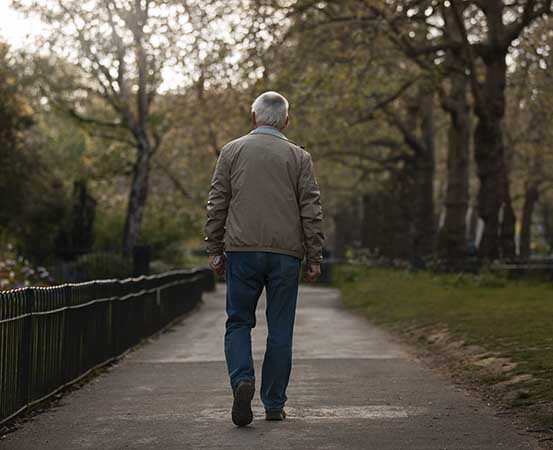
Aging has its positives and negatives. The grey hair and the decline in vision and hearing are among the obvious downsides. However, the rate of decline can be slowed through exercise and other interventions.
Talking about exercise, one of the positives of advancing years is that it offers leisure time to pursue activities that one enjoys. Many elderly people, however, restrict their movement, sometimes even within the house, fearing falls and injuries because of muscle weakness and balance issues.
While strength training exercises can make them stronger, balance training drills can give them confidence to move around at will, without support or the fear of falls.
How aging affects balance
As people grow older, the functions of various parts in the body start to slow down. There is evident decline in the function of the sensory systems such as vision, hearing and proprioception. As all of them are important, their impairment affects balance.
“Neurological changes, that include decrease in nerve function and slower reaction times, can affect the body’s ability to respond quickly to maintain balance,” says Pooja Pandey Tripathi, a physiotherapist from Bangalore. “Certain medications or health conditions, such as cardiovascular issues or neurological disorders, can affect blood pressure, vision or cognitive function, contributing to balance problems. Joint degeneration, such as arthritis, can affect stability and mobility too.”
A sedentary lifestyle is another culprit for speeding the process of muscle weakness, reduced flexibility and coordination, all of which are responsible for maintaining balance.

Balance training exercises for seniors
Yoga and tai chi are some of the recommended physical activities for improving balance, but there are other simple and specific balance training exercises too.
“Incorporating balance training exercises — which focus on strength, flexibility and coordination — into the daily routine helps improve balance,” says Prakash Jay, a fitness consultant and holistic wellness coach from Bangalore.
Jay lists out some easy-to-do balance training exercises for seniors:
- Seated leg lifts: Lift one or both the legs while remaining seated on a stable chair. Extend the knees and hold and place it back. This helps strengthen the leg muscles, contributing to stability.
- Chair squats: Using a chair for support, squat to increase leg strength and balance.
- Toe taps: Do toe taps, by stepping up and down on an elevated surface by alternating feet. This helps improve ankle flexibility and balance.
- Standing calf raises: Raise the heels to stand on tiptoe, pause and drop the heels back. This strengthens the calf muscles and improves ankle stability.
- Side leg raises: Stand straight and lift one leg to the side, then bring it back. Repeat with the other leg. This helps improve hip strength and balance.
- Spot marching: Lift knees alternately while standing straight. This exercise improves coordination and balance.
- Walking heel to toe: Walk in a straight line, placing the heel of one foot directly in front of the toes of the other.
- Heel and toe walking: Walk on your heels for a few steps, then on your toes. This promotes ankle stability.
- Backward walking: Safely walk backward to improve balance and engage different muscle groups.
Dr Tripathi adds two more exercises to the list.
- Standing on one leg: Hold on to a sturdy surface for support if needed, then lift one foot slightly off the ground and balance for 10-15 seconds. Switch legs and repeat. Gradually increase the duration and try to do the exercise without holding anything for support.
- Balancing on foam or cushions: Stand on a foam pad or cushion with both feet and try to maintain balance for 30 seconds to a minute. As your balance improves, you can make it more challenging by closing your eyes or standing on one leg.

Breathing exercises for improving balance
“Sometimes even taking time to observe your normal breathing pattern can help with improving your balance,” says Jay.
Ensuring safety while doing these exercises is of the utmost importance. They should be done standing next to a stable chair, table or counter for support. After getting the exercises approved by a healthcare professional, begin with the ones that are easiest and gradually progress to the next level.
Significance of balance training exercises for elderly people
Improved quality of life is undoubtedly the most important benefit of balance training. Dr Tripathi lists out the positives:
- Fall prevention: Accidental falls and injuries due to sudden movement, which can result from muscle weakness and impaired balance, can be reduced with balance training.
- Being independent: Enhancing balance and coordination allows people to do daily activities such as walking, standing and reaching for things or tasks without help or support.
- Improving confidence: Being secure on the feet increases confidence and reduces anxiety and fear of falls. It encourages older people to engage in physical activities and social interactions, promoting overall well-being.
Takeaways
- Loss of balance as one grows older results from neurological changes, muscle weakness, reduced flexibility and coordination, and changes in sensory perception such as vision, hearing and proprioception.
- Simple balance training exercises for seniors include one-leg stand, balancing on foam or cushions, seated leg lifts, chair squats, standing calf raises and walking heel to toe.
- Balance training helps improve confidence and independence, and prevents falls and risk of injuries, thereby enhancing quality of life in old age.
















